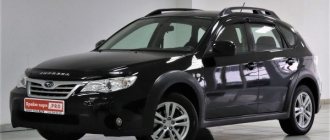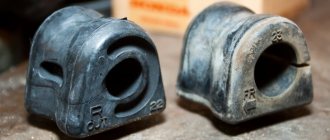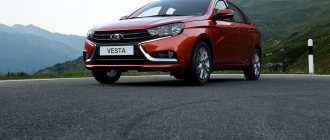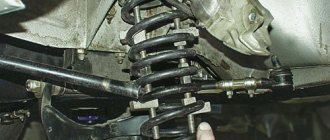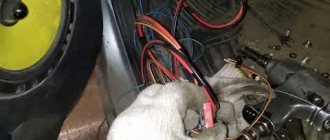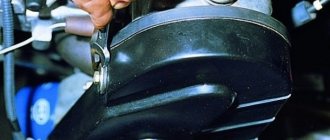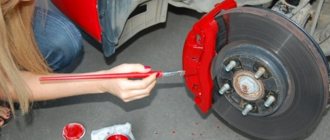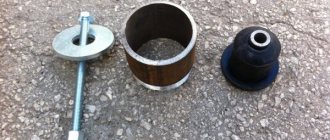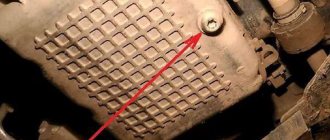Stabilizers are responsible for the vehicle's stability on the road. To eliminate noise and vibration from the operation of the components of the stabilizers, special bushings are used - elastic elements that give smooth operation.
What is a bushing? An elastic part is created by casting from rubber or polyurethane. Its shape remains virtually unchanged for different car models, but sometimes has some features depending on the design of the stabilizer. To improve the performance of bushings, they sometimes have bosses and grooves. They strengthen the structure and allow parts to last longer, and also protect against mechanical stress that can damage them.
What tools are needed?
If the suspension begins to make noise when you increase speed or hit an obstacle, you can talk about a malfunction of its elements. In such cases, replacement of the stabilizer bushings is most often required. To do this you need to prepare the tools:
- head collar,
- ratchet,
- a metal brush, which is needed to clean the seat and stabilizer from rust,
- a brush for applying penetrating lubricant,
- stationery knife for cutting the sleeve.
Features of dismantling
Replacing such an important structural element of a machine's chassis as a bushing requires a responsible approach. If rubber products were previously installed, it is advisable to replace them with polyurethane ones created by the Tochka Opory brand. Polyurethane parts make driving easier even when overcoming difficult road conditions. In addition, they protect the suspension and body and have a long service life.
Dismantling begins with cleaning the mounting bolts and applying penetrating lubricant to facilitate the process. After this, the fastening nuts are unscrewed and the stabilizer bushing brackets are dismantled. Rust and rubber residues must be removed from all working surfaces. For their additional protection, lubricant is used. After removing the old products, you need to inspect the stabilizer itself and the seat.
Smooth road to everyone: how and why to change stabilizer bushings
The anti-roll bar is an interesting thing. Its main feature is that it is often underestimated by car enthusiasts, especially those who have recently driven or have never seen anything cooler than a “nine” with leaking shock absorbers. Indeed, you can completely remove it and throw it away - the car will still drive. It's really bad.
No need to heel!
If cars always drove in a straight line, without accelerating or braking, a stabilizer would not be needed at all. Its work begins every time the car tries to tilt. Whether it's lateral roll when turning or longitudinal roll when braking, the stabilizer tries to keep the body parallel to the road surface. And despite the elementary design, he does it well.
The stabilizer is just a rod connecting the subframe to the wheel mount (today we will talk about the MacPherson front suspension, so let’s put it more simply - with the suspension arm). It should be noted that MacPherson really, really needs the use of a stabilizer, mainly due to some compromise in the design. The camber angle there is static, but during roll it changes due to the peculiarities of the suspension design. Why is this bad? Because changing camber angles inevitably reduces the area of contact between the tire and the road. And the only way to avoid this phenomenon is to reduce the roll. This is where the stabilizer, which works like a torsion bar, helps: with a lateral roll, the opposite ends, fixed in the levers, begin to move in different directions, twisting the middle part. The resulting moment prevents further relative movement of the wheels, reducing roll. As you can see, it works very simply.
But in order not to become a fan of the cult of the stabilizer, it is necessary to say a few words about its shortcomings. Firstly, the stabilizer willy-nilly reduces the suspension travel. Of course, this is not critical for a passenger car, but for an SUV it can be harmful. Well, secondly, you shouldn’t get carried away with replacing the stabilizer with something more rigid, which some car owners sometimes like to do. In their opinion, a more durable stabilizer will help to almost completely avoid rolls and turn the Zhiguli into a Formula 1 car. This is a very dangerous misconception.
The first thing Kulibin will encounter with an arm-thick piece of iron in the front suspension is an unexpectedly easy drift due to an unhealthy imbalance of the grip of the front and rear wheels with the road (it will be insufficient for the rear wheels). It must be understood that the engineers who developed the suspensions carefully calculated not only each of the suspensions, but also their joint work. And if you incorrectly interfere with the operation of one of them, the overall controllability will decrease, although the roll, quite possibly, will become a little less.
So, what does the bushings have to do with it, and why change them? As I already said, the stabilizer must be able to twist from multidirectional forces on the right and left wheels. If it is welded or rigidly attached to the subframe in any other way, it will be deprived of this opportunity, which is why it is attached to it using bushings. Over time, they wear out, and the stabilizer begins to “walk” in them.
This play, like any other, increases the degrees of freedom of the part, which nullify all its ability to prevent roll. And then, when cornering, the car begins to lean on its side more than it should.
Not every car enthusiast will immediately notice this, so they change the bushings in other cases: if wear is detected during suspension diagnostics, or if it is already starting to knock. However, the second situation is usually more typical not due to physical wear, but due to a good impact or other mechanical impact.
So, we have come to understand that bushings must be replaced periodically, and this is completely normal. Let's see how to do this.
What will you need?
What's great about this renovation is that it's inexpensive. And I would even say that there is no point in doing it with your own hands, no matter how skillful they may be. Therefore, let's go to the service center and just watch how a specialist does it.
You will need a minimum of tools: an 18 mm socket and a 10 mm wrench (or socket). But look at the wrench: why has life crippled it so much? In fact, what we have in front of us is not just a key, but the Modernized Special Tool of Alexey Teleshov, we will call it that.
Since we will be changing the bushings on Logan, we will have to take into account some of its features, so such a tricky key may come in handy. In addition, you will have to look for a lift, and quite possibly a hydraulic strut (we used it, in any case) along with an angle grinder. So, despite the apparent simplicity, everything is not so simple.
Now about the cost of spare parts. There is no point in chasing the original, there are very worthy manufacturers, especially since the bushing is a piece of elastic, and it is not so difficult to do something there. Therefore, we pay attention to two popular models: the French Sasic for 160 rubles and the Belgian Sidem for 180. We will choose Sasic.
We go into the box and get on the lift.
As usually happens with threaded connections at the bottom of the machine, they have all long since become covered with a layer of dirt and have become sour. Therefore, before starting work, it makes sense to spray the bolts with WD 40. We wait a little and pull out the same key with a broken fate and try to unscrew the bolt ten from the top (seen in the photo).
Naturally, this is as useless as asking a cat to quickly walk through an open door (if you have a cat, you will understand the futility of the plan). But in this case, the design of the Logan suspension itself helps us: this bolt is usually simply cut off, because its purpose is unclear to anyone, even in the heavier and off-road Duster this unit is made simpler and a little more gentle (and the bolt has a smaller diameter). Therefore, the specialist draws a mark with a white marker at which it will be necessary to cut off the ear of the clamp. Now it’s up to the “grinder”: cut off this ear and move to the other side.
Installation of polyurethane parts
New bushings are supplied as a set of two, waterproof grease for installation and instructions. To begin with, they are cut in the place where the dismantled parts were cut. To do this, use a stationery knife, which is pre-moistened in water to make work easier.
Lubricant is applied inside the bushing with a brush. Clamps must be protected from dirt and rust. Otherwise, the product will be deformed and a creak will appear inside it. It is imperative to clean the seat, and treat the stabilizer with a special lubricant to remove dirt and dust.
Polyurethane products should be installed with a cut in the same direction in which the worn parts were located. All that remains is to put the brackets in place, attach and tighten the nuts. The tightening torque should be set in accordance with the instructions. The video will tell you more about replacing the stabilizer bushing.
Replacing stabilizer bushings
Stabilizers are responsible for the vehicle's stability on the road. To eliminate noise and vibration from the operation of the components of the stabilizers, special bushings are used - elastic elements that give smooth operation.
What is a bushing? An elastic part is created by casting from rubber or polyurethane. Its shape remains virtually unchanged for different car models, but sometimes has some features depending on the design of the stabilizer. To improve the performance of bushings, they sometimes have bosses and grooves. They strengthen the structure and allow parts to last longer, and also protect against mechanical stress that can damage them.
Why the Tochka Opory brand?
We recommend using polyurethane bushings from the Tochka Opory brand as new car suspension elements. Spare parts made of polyurethane prevent premature wear of the vehicle's chassis. In addition, polyurethane products, due to their elasticity, resistance to natural factors and unpretentiousness, are ideal for use in the climatic conditions of Russia.
Most rubber bushings lose their properties due to exposure to adverse factors. Polyurethane parts will maintain performance even at low temperatures. At the same time, vehicle handling will be better, and the frequency of replacing suspension elements will be reduced.
In our online store you can buy stabilizer bushings made of polyurethane from the Tochka Opory brand: we always have a large selection of products from this brand in stock. Experienced managers will help you with choosing a product in the IXORA store.
| Manufacturer | Detail number | Part name | Applicability* |
| TOCHKA OPORY | 3021414 | FRONT SUSPENSION BUSH, STABILIZER LINK MITSUBISHI | MITSUBISHI COLT Z2 (2002.10 - ) PAJERO MINI H53A, H |
| TOCHKA OPORY | 1011041 | BUSHING STABILIZER, FRONT SUSPENSION TOYOTA, ID = 22 MM | TOYOTA AVENSIS AZT250, AZT255 (2003.07 - ) |
| TOCHKA OPORY | 101897 | BUSHING STABILIZER, REAR SUSPENSION TOYOTA | TOYOTA AVENSIS AZT250.. 251…SED (2006.06 - ) WG..LI (2003.07 -) |
| TOCHKA OPORY | 101755 | BUSHING STABILIZER, FRONT SUSPENSION TOYOTA, ID = 23 MM | TOYOTA CAMRY ACV30 |
| TOCHKA OPORY | 101040 | BUSHING STABILIZER, REAR SUSPENSION TOYOTA | TOYOTA COROLLA AE101 (1997.05 - 2000.08) SPRINTER AE101 GT |
| TOCHKA OPORY | 9012176 | STABILIZER BUSHING, FRONT SUSPENSION SUZUKI, ID = 25.5 MM | SUZUKI GRAND VITARA |
| TOCHKA OPORY | 26012665 | STABILIZER BUSH, REAR SUSPENSION GREAT WALL, ID = 18.3 MM | GREAT WALL HOVER SAFE |
| TOCHKA OPORY | 101758 | BUSHING STABILIZER, FRONT SUSPENSION TOYOTA | TOYOTA COROLLA FIELDER COROLLA RUNX ALLEX NZE124, ZZE124 C |
| TOCHKA OPORY | 8011034 | BUSHING STABILIZER, FRONT SUSPENSION SUBARU | SUBARU FORESTER SH5, SH9, SHJ (2007.09 - ) LEGACY B4 BL5, B |
| TOCHKA OPORY | 8011643 | BUSHING STABILIZER, REAR SUSPENSION SUBARU, ID = 1 | SUBARU IMPREZA (2008.07 - ) FORESTER (2007.09 - ) |
| TOCHKA OPORY | 12011506 | STABILIZER BUSH, FRONT SUSPENSION HYUNDAI, ID = 18.5 MM | HYUNDAI ACCENT VERNA (1999 - ) |
| TOCHKA OPORY | 3011213 | BUSHING STABILIZER, FRONT SUSPENSION MITSUBISHI | MITSUBISHI LANCER MIRAGE ASTI CS5A, CS5W AIRTREK CU4W |
| TOCHKA OPORY | 4012198 | STABILIZER BUSH, REAR SUSPENSION MAZDA, ID = 17.5 MM | MAZDA CX7 ER (2006 - ) |
| TOCHKA OPORY | 17032072 | SHOCK ABSORBER BUSHING, REAR SUSPENSION VAZ, MOSKVICH, ID = 15.5 MM | VAZ 2101, MOSKVICH 2140 |
| TOCHKA OPORY | 202658 | FRONT AND REAR SUSPENSION BUSHING, STABILIZER LINK, CONE NISSAN, ID = 10 MM | NISSAN SENTRA B1 |
| TOCHKA OPORY | 12012703 | BUSHING STABILIZER, FRONT SUSPENSION KIA | KIA MENTOR (HB) I, II (1997 - 2004), KIA CARENS (1999 - 2002) |
| TOCHKA OPORY | 301886 | BUSHING STABILIZER, FRONT SUSPENSION MITSUBISHI | MITSUBISHI PAJERO V64W, V65W, V68W, V73W, V74W, V75W, V78W |
| TOCHKA OPORY | 9011037 | BUSHING STABILIZER, FRONT SUSPENSION SUZUKI | SUZUKI ESCUDO TD54W (2005.05 - ) TA74W (2006.06 - ) TD94W |
| TOCHKA OPORY | 12012564 | STABILIZER BUSH, REAR SUSPENSION HYUNDAI, ID = 16.5 | HYUNDAI I30 I30CW (2008 - ) ELANTRA (2006 - ) |
| TOCHKA OPORY | 3011717 | BUSHING STABILIZER, FRONT SUSPENSION MITSUBISHI | MITSUBISHI COLT CABRIOLET Z36A, Z37A REGION EUROPE COLT Z31A |
* Please check the applicability of parts specifically for your car with our managers by phone (calls within Russia are free).
Modern car suspension
Design and operation of the suspension
The main task of the suspension is to provide an elastic connection between the body and the wheels. Thus, the suspension softens the shocks and jumps that occur when the car moves on an uneven road or its absence. The smooth ride of a car directly depends on the suspension.
The suspension serves as a kind of shock absorber, absorbing the energy that occurs when hitting bumps or falling into holes and ruts. However, it does not guarantee complete smoothness of movement and wears out greatly with frequent movement over uneven surfaces.
Pendants are divided into the following types:
- McPherson;
- double lever;
- multi-link;
- adaptive;
- "De Dion"
- rear dependent;
- rear semi-independent;
- pickups and SUVs;
- trucks.
McPherson type suspension
The McPherson type suspension is one of the oldest. It was developed by the talented engineer Earl McPherson in 1960. Consists of a stabilizer bar, a lever and a block. A serious disadvantage of the suspension is the change in the wheel camber angle, but it is very popular due to its availability and reliability.
Double wishbone suspension
The double wishbone suspension is one of the most advanced designs. This is a suspension with two arms of different lengths (the upper one is short and the lower one is long). This design allows the car to maintain stability on the road and ensures the durability of the tires. Each wheel accepts its own obstacle independently and does not transfer the load to the other wheels.
Multi-link suspension
The multi-link suspension was developed not so long ago and is an even more advanced design. It is a set of many levers, silent blocks and hinges. All these components are designed to absorb shocks and strong shocks while driving. The noise level from the wheels in the cabin is also reduced. The suspension has separate lateral and longitudinal adjustments. The wheels are independent of each other. The design is ideal for all-wheel drive vehicles.
The cost of a multi-link suspension remained quite high for some time, but now even golf car drivers can afford it.
Adaptive suspension
The adaptive suspension is very interesting from a design point of view. For a long time it was primitive and weighed a lot, but now it has been greatly modernized. Thanks to this, it allows maximum body roll and wave swing at high speed and allows you to automatically adapt to any type of road surface. The adaptive suspension includes: adjustable anti-roll bars, active shock absorber struts, a chassis control unit and electronic sensors that record road irregularities and other parameters.
"De Dion"
“De Dion” is named after its French creator. The main function of such a suspension is to reduce the load on the rear axle of the car by separating the final drive housing. In this case, the crankcase rests on the body. This design allows you to make the suspension dependent or independent. But there are also disadvantages. With a sharp start, the car body can put a lot of pressure on the rear axle.
Rear dependent suspension
The rear dependent suspension is a real classic option, as it was used on many old VAZ cars. The suspension is based on cylindrical coil springs, which are elastic elements. The rear axle beam “hangs” on springs and is fixed to the body by means of four longitudinal arms. The reactive crossbar acts as a roll absorber and has a positive effect on handling. But don’t expect comfort and smoothness from this suspension, since the rear axle weighs a lot.
This is interesting: 3 main ways to cover a car with liquid rubber
Semi-independent rear suspension
Semi-independent rear suspension is most often used in vehicles with all-wheel drive. Its main elements are two longitudinal arms attached in the center to the cross member. This suspension weighs little and does not require any special maintenance or major repairs. But such a suspension can no longer be installed on rear-wheel drive cars.
Other types of pendants
Pickup trucks and SUVs have different suspensions. There are completely dependent and completely independent varieties of such suspension. Dependent suspensions are used less frequently, since the rigid connection of the wheels to each other leads to large loads, reduced controllability and other troubles when driving off-road. Much more popular is the spring system, which is more soft.
The suspension of trucks is most often dependent with transverse or longitudinal springs and hydraulic shock absorbers. This design simplifies the process of producing and repairing trucks.
